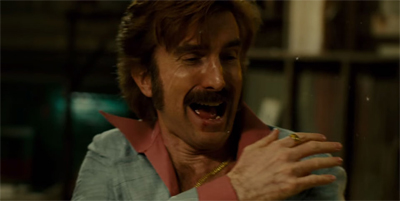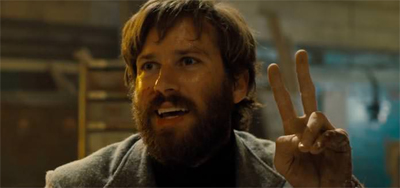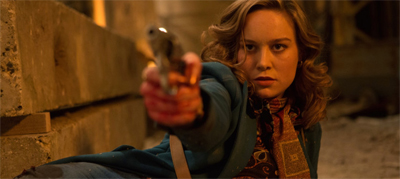This film was seen as part of the Audi Dublin International Film Festival 2017.
Free Fire is probably best described as “Character Actor Death Match.”
Director Ben Wheatley draws together a fine collection of recognisable and veteran character actors for his single-location thriller. Free Fire has a cast including Brie Larson, Armie Hammer, Cillian Murphy, Jack Raynor, Sam Riley, Sharlto Copley and Wheatley fixture Michael Smiley. The premise is remarkably straightforward. In Boston, in 1978, a bunch of Irish Republicans set out to buy some guns from an unreliable South African arms dealer, with various other parties caught in the crossfire.

All fired up.
The weapons deal gradually breaks down, whether due to mistrust between the parties or personal animosity between individuals. The abandoned industrial warehouse chosen to host the deal quickly descends into anarchy, with characters drawn into a sprawling (and intentionally muddled) fire-fight in which many of the participants seem entirely unclear about what is happening and which group to which their allegiance lies. “Sorry!” one character apologises over a cheap shot at a supposed ally. “I forgot which side I was on!”
Free Fire is a fast-moving free-wheeling absurdist action comedy that leans heavily upon a fantastic cast and on the director’s mischievous sense of fun.

Shooting the Brie-ze.
Free Fire might just be Ben Wheatley’s most accessible film. The director has an impressive filmography with a very diverse array of films, from the pagan hit man thriller Kill List to the J.G. Ballard adaptation High Rise. However, these works were mind-bending and abstract pieces of cinema, feeling far more at home in the art house than the multiplex. In contrast, the plotting and internal logic of Free Fire is a lot more straightforward. There are characters, there are guns, there is a warehouse. There is a stand-off. There is (arguably) one really long gun fight.
The result is a film that arguably has a much broader appeal than something like A Field in England. It is a movie that can be enjoyed straightforwardly and on its own terms, as an action comedy about a bunch of great actors playing distinct (and heighted) characters trapped in a confined location and engaged in a stand-off that threatens to escalate to “last-man-standing” proportions. And Free Fire works very well on those terms, it is funny and well-observed, following through on its premise with both charm and wit.

Shouldering responsibility.
However, it is also very much a Ben Wheatley film. There is no sense that Wheatley has surrendered anything that makes him distinct as a filmmaker in telling this story. In fact, Free Fire is just as much a product of Wheatley’s standard working practices. Free Fire is co-written and co-edited by Wheatley’s long-standing collaborator (and spouse) Amy Jump, and features veteran Wheatley collaborator Michael Smiley in a prominent supporting role. Free Fire is in no way a compromised film.
This is very obvious in the way that the film plays out, most notably in the final act as the action becomes increasingly unhinged. An endearing oddness runs through the film from the outset, most notably in the introduction of Armie Hammer’s bearded (and jumper-wearing) middle-man Ord and escalated once Sharlto Copley’s fast-talking-say-nothing arms broker Verne enters the fray. However, while the first two thirds feature fairly conventional gun play, the final act of the film becomes increasingly bloodthirsty and brutal in the wounds it inflicts on the cast.

A hairy situation.
However, there is something even more fundamentally Wheatley about Free Fire, in that it continues to play to some of the writer and director’s key interests and themes. Free Fire is largely free of the occult imagery and symbolism that defined Kill List, A Field in England or High Rise. However, it remains preoccupied in the strange relationship that exists between individuals and their surroundings. Free Fire might be an ensemble action comedy, but its filming location is arguably as much a player as any of the cast.
The bulk of Free Fire unfolds in a broken down and dilapidated warehouse on the edge of Boston. “I wonder what they used to make here,” Justine reflects on her way to the meeting. “Whatever it is,” Chris reflects, “I don’t think anyone’s buying it anymore.” Chris eventually discovers what it is the factory used to make, in a delightfully ironic joke at the end of the film. There is a sense of decay and collapse to the environment, with its smashed walls and its rusted pipes, the creaking stairwells and the debris scattered across the floor even before the gun fight begins.

Planning grand Larson-y?
The place seems almost built to serve as an urban warzone, as if begging to be repurposed for a lethal game of urban airsoft. Indeed, Free Fire suggests that violence was always going to result from this meeting in this place, even if it did not arise from these particular circumstances. The warehouse quickly lends itself to this gunplay, as characters cower behind fixtures and shelter under shattered pillars. As if affected by this decaying urban environment, long-standing civil bonds are chipped away as easily as the stonework; family and friends mean nothing in an urban warzone.
Wheatley repeatedly teases a malevolence to these collapsing surroundings. Bullets ricochet off stone and pipework to wound and scar various characters. Every time it looks like some of the characters might possibly escape, or like peace might be possible, the environment reveals some hidden detail to escalate the tension and get the bullets flying. There are always explosive canisters tucked away behind locked doors ready to spill out at the worst possible moment, or phones hidden away and ready to shatter a precarious peace.

Between One Verne.
There is a faint suggestion that the characters are being manipulated or corrupted by their surroundings. While Verne panics about the flesh wounds he received early in the fight, Ord calms his colleague by reassuring him that “the golden rule” says he has “an hour and a half” before he has to worry. Verne pauses. “How long have we been here?” Time is an ethereal construct. Similarly, Verne later becomes obsessed with the fear of “infection” and (without a hint of irony) starts fashioning body armour from the environment around him.
It is perhaps too much to argue that Free Fire is a critique of social and political systems that push individuals into conflict and turn civil society into a brutal blood bath. After all, Free Fire is great fun even if treated as a simple high-stakes shoot-’em-up. However, Free Fire is also a Ben Wheatley film, and so his own interests and ideas percolate through it. For all that Free Fire is a more conventional film than some of Wheatley’s early work, it is in no way a compromised film. It reflects its writer and director, through every layer of the production.

“Give me ammo-ment.”
Free Fire is a joy from beginning to end, a pleasure.
I don’t normally rate films, but the Audi Dublin International Film Festival asks the audience to rank a film from 1 (worst) to 4 (best). In the interest of full and frank disclosure, I ranked this film: 3
Filed under: Non-Review Reviews | Tagged: Ben Wheatley, film, free fire, Movie, non-review review, review |




















Leave a comment